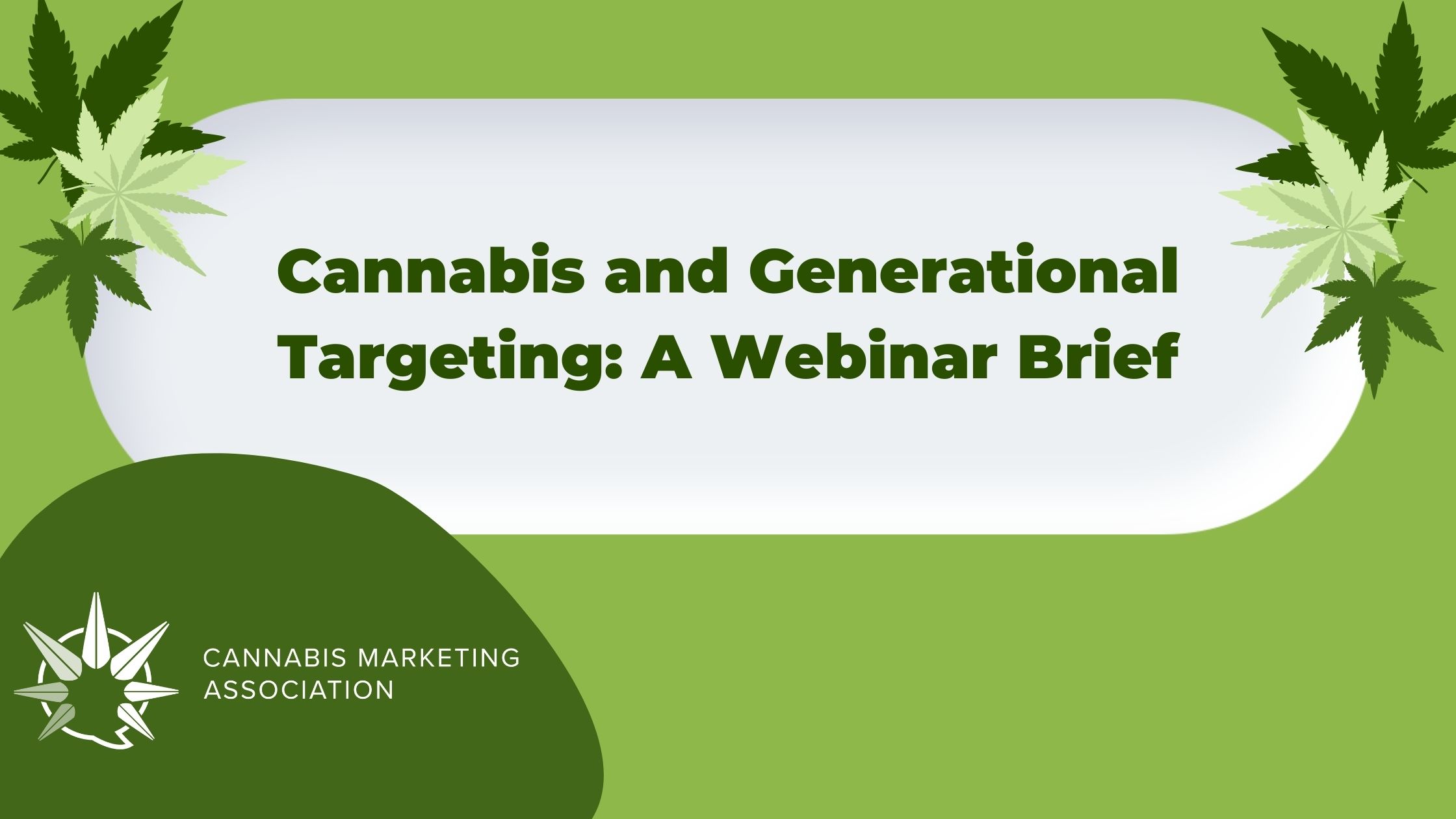Cannabis and Generational Targeting
A CMA Webinar Brief
By Emily Wells
On October 12, Cannabis Marketing Association was joined by Drew Pedersen, Director, Northwest of MNI Targeted Media to discuss preferences and marketing tactics by age segmentation.
The presentation began by briefly polling attendees and posed three questions about four key generations, Baby Boomers, Gen X, Millennials, and Gen Z, and their behaviors and attitudes surrounding cannabis. Drew revealed that Boomers post the most positively about cannabis online, Millennials tend to be early adopters of technology and supportive of social movements like cannabis consumption, Gen Z was the first generation to reach adulthood with cannabis legalization becoming widespread in many states, and all four age cohorts saw growth in cannabis spend in 2020.
Cannabis and Generational Targeting was broken down by generation and the things that defined them each, their media and cannabis consumption trends, the things learned about each generation, and unveiled what each generation had said about cannabis using social listening tools.
Baby Boomers (1946-1964)
Baby Boomers are defined as the generation who witnessed the Civil Rights Movement, the Vietnam War, and the first moon landing and were born between 1946 and 1964. When it comes to media consumption, their go-to digital channel is email; however, they default to print, TV, and radio, and deeply trust magazines — Boomers frequently have glossy subscription catalogs displayed in their homes as they favor long-form content.
Boomers represent 22% of the U.S. population and are one of the fastest-growing cannabis and CBD-consuming audience segments. From 2015 to 2018, this demographic saw a 75% increase in cannabis consumption. When discussing cannabis online, Baby Boomers tend to be the least negative as they habitually use social media to find new information and share positive experiences. Using social listening tools, MNI has found that, “I feel cannabis is a healthier option than alcohol” is a sentiment 91% of Boomers agree with.
Their customer journey typically begins in-store, but sometimes they find items online or on their mobile devices — they rely on digital media to research their options. Unlike the generations that succeed them, Boomers have a distaste for content that is personalized. If you overdo personally-curated content, you risk scaring your Boomer consumers away.
Generation X (1965-1980)
Generation X, born between 1965 and 1980 is the “middle child” of the four generations — often overlooked, but this segment is defined by the fall of the Berlin Wall, Y2K, and Watergate. More digitally savvy than Boomers, Gen X prefers that any marketing messaging they receive comes from known sources. Digital videos are an indispensable component of their media mix, and they’re more loyal to TV than the generations that follow.
Gen X tends to use social media for socializing as opposed to shopping and prefers Facebook and Instagram to other social media platforms. A strong message in a magazine may resonate well with them, but Gen X is more connected to email than you would think. When accessing the web, Gen X is generally not mobile-first and prefers to get online using their desktop, but be sure to maintain a balance of well-curated, personal, social content that doesn’t make the consumer feel like they’re being stalked.
Gen X are time-pressed and often caring for aging parents and children of their own and notably health-literate. Although the generation as a whole is divided on the benefits of CBD and cannabis products, with many debating their effectiveness, 93% of Gen-Xers agree that “cannabis use has many health benefits and can be good for the mind and body”.
Millennials (1981-1996)
Also known as the “Trophy Generation” or “Gen Y”, Millennials were born between 1981 and 1996 and recall 9/11, the Great Recession, Obama’s election, Sandy Hook, and the rise of Facebook. Millennials are heavily into OTT/CTV advertising as they spend most of their media-consumption time on screens of all sizes, but primarily smartphones, and want to be rewarded for their brand loyalty.
Millennials are early adopters of technology and sites like Amazon are a go-to; if you can effectively align your marketing with new trends and new technology, you’ll break into the future. This generation conducts device-agnostic research online, but still prefers to make purchases in-store rather than online. Advertising targeting millennials can be more personalized, as they’re a segment mostly comfortable with sharing their browsing data and behaviors.
Interacting with brands socially is the norm for Millennials and they are in favor of more regulation to ensure the safety, quality, and efficacy of CBD and cannabis products. Millennials tend to tout the benefits of using cannabis and CBD products for stress, anxiety, and wellness online — 92% of Millennials agree that they trust the quality of the cannabis products they consume and 91% of Millennials agree that cannabis use should be normalized.
Generation Z (1997-2010)
The fourth and final generation analyzed was Generation Z. Still a rising generation, Gen Z was born between 1997 and 2010 and came of age following 9/11 and the aftermath of the Great Recession; the youngest of them are still adolescents.
Gen Z are content creators, sharers, and consumers who are highly selective, only giving their attention to the content they deem deserving of their time. They mostly interact via visual platforms, like Snapchat, TikTok, and Instagram, and prefer platforms that allow them privacy and anonymity, such as Whisper, Secret, and Yik Yak. Social impact is largely prioritized by Gen Z and their favorite brands follow sustainable practices.
In terms of cannabis consumption, Gen Z cares less so about brand loyalty and leans toward THC products instead of CBD products, and their most frequently purchased cannabis product is pre-rolls. 81% of Gen-Zers say they use cannabis as a wellness tool, and 89% of Gen-Zers agree that cannabis consumption is one of their favorite ways to relax.
Conclusion
Ultimately, the best way to reach each generation is to invest the time to understand their audience preferences and what makes them tick, identify how each audience group consumes content, interacts with media channels and likes to be reached, and personalize messaging to what the age cohort values most (except for Baby Boomers!) and share how your brand delivers on these values.
Drew concluded his generational analysis by acknowledging that he would be remiss not to discuss women — how to reach them, how to ensure your marketing message matters, and why cannabis marketers should put effort into advertising to women.
Watch the recording below to learn more about specific tactics and practices to reach each generation respectively and how MNI Targeted Media implements data targeting and utilizes cannabis marketing solutions.
Interested in accessing CMA’s content portal with all of our past event recordings? Become a CMA Member today! Webinar attendees receive 10% off using the discount code Webinar10.


